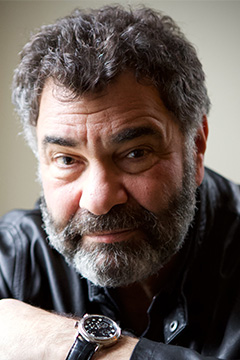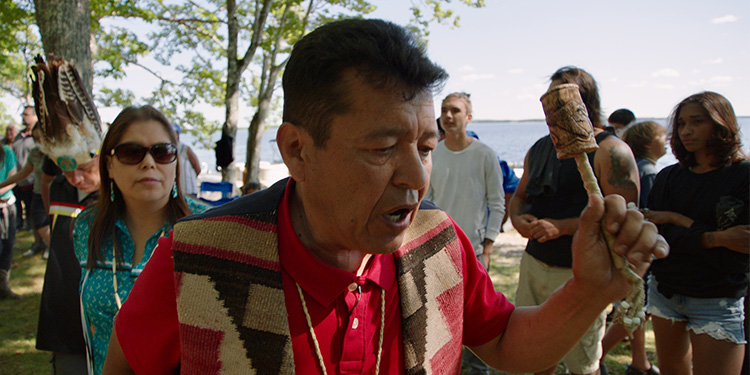Nurturing the Native Talent of ‘Native America’
October 23, 2023
In episode 2 of 'Native America,' titled 'Language is Life,' Dwayne Tomah, a language keeper of the Passamaquoddy people, leads the community in song. Photo courtesy of Providence Pictures.
Season 2 of “Native America,” premiering October 24 on PBS and its digital channels, offers a groundbreaking portrait of contemporary Native America, produced by a team that emphasized Native participation in all aspects of production. Executive Producer Gary Glassman of Providence Pictures hired a majority Native staff – from series producers and episode directors, cinematographers, sound engineers, production assistants, writers, editors, animators, and musicians – to enhance the cultural integrity of the series.
The Corporation for Public Broadcasting invested more than $1 million in “Native America,” including engagement events hosted by tribal public radio stations across the country through Native Public Media and Koahnic Broadcast Corp. CPB’s production funding included a mentorship and support program for the talented creatives, many of whom had experience with small, self-shot films but no credits in a major national production.
The producers worked closely with the creative team, facilitating group meetings to help build a community of support. The result was a collaboration with a depth of access and a sense of intimacy rarely seen on television, career growth for both Native and non-Native crew members, and multi-generational engagement to promote the series in Native communities across the country.
CPB caught up with Glassman and series producer and director Daniel Golding (Quechan) to tell us the story behind the series.
Q: How did Season 2 build on the Native-centered storytelling of the first season of “Native America”?

Gary Glassman: Season 1 of "Native America" is about the world created by America’s First Peoples from 15,000 years ago to today.
Season 2 opens a door into contemporary Native America and shows how Native values and knowledge live on, even as Native people live fully modern lives – whether running for office, going for gold in the Olympics, or landing Rovers on Mars.
While Season 1 was produced in deep collaboration with our Native participants and communities, we wanted to go further for Season 2 and have all four episodes produced and directed by Native filmmakers. The result is a visceral authenticity of storytelling, and authenticity makes great TV.
Q: Adding time to the production schedule was a major aspect of the mentorship and support program. What did the extra time allow you to do?
Gary Glassman: Extra time gave us the opportunity to build our team and create a common vision for the series. While there are many incredibly talented Native filmmakers, not many have had the opportunity to work on a national PBS series, and there is a big difference between making your own indie film and working on a four-part series. With that extra time, we were able to share organizational and creative practices that Providence Pictures has developed over the years and for our Native colleagues to share the knowledge they have gained from filming with Native communities. This transparency of purpose and communication of that purpose helped build trust among us and, ultimately, that led to trust with the Native participants and communities who so generously shared their stories.
Q: What specific steps did you take to develop trust, and why was that necessary?
Gary Glassman: At the heart of our process was guidance we offered for field preparation. Rather than rush our teams into the field, we ensured each member was fully equipped for their shoots. We developed a step-by-step system to develop, refine, and prepare for each story. We also had group meetings where team members mutually supported one-another, compared notes, and built a community of excellence.
These steps maximized success and flexibility in the field. And critically, rather than a traditional supervisor-employee relationship, these exchanges were built on mutual trust and collaboration.
Through all of this, the robust cross-cultural working environment on the project created a patient and open-minded energy that positively impacted every one of our team members – both Native and non-Native. In contrast to many production environments, collaboration became central to everyone’s standard working style, and this has elevated the entire “Native America” team.
Finally, our team asked for the opportunity to help learn the process for creating network-level pitches. We created a new specific series of training and onboarding steps to introduce them to the development process. They created the foundation of a proposal for what could be Season 3 of “Native America.”
Q: Were there examples of how the Native crew was able to tell stories that a non-Native crew wouldn’t have been able to?

Daniel Golding: The Native crew had a direct connection to the communities and people they were working with through shared experiences and cultural similarities. Such is the case with the 130-year-old Passamaquoddy wax cylinder recordings that were returned after being remastered to make them clearer to hear and understand the language being spoken. I was the producer/director of this “Language is Life” episode. My great grandfather was also recorded on wax cylinder over 100 years ago. As a Native producer, I was able to reach a little bit deeper through a level of comfort through these shared experiences, allowing both (tribal historic preservation officer) Donald Soctomah and (language keeper) Dwayne Tomah to gain trust and welcome us into their community.
Another example is the Pueblo Revolt story in the Warrior Spirit episode. The Pueblo communities are very protective of how their stories are told. They are sensitive to who they work with and how to develop trust. We had several Zoom meetings with Gil Vigil from the Tesuque Pueblo on allowing us access to their community to share the story of Catua and Omtua, two martyred runners from Tesuque who are honored every year through a memorial run. Segment Producer Mandolin Rain Song, who is from Taos Pueblo, knew how best to proceed culturally to gain trust with the community and tell this story, which Gil and the Council approved. Native producers can step around stereotyped stories of Native America and give a deeper understanding to the themes and issues shared by all tribes across Native America.
Q: Were there specific needs of Native creators that were important for the mentorship program to address?
Daniel Golding: “Native America” Season 2 took a community focus toward storytelling. With this comes a responsibility to understand the communities whose stories we are telling and to participate in them as any other community. There’s something in Indian Country called “Indian Time.” It was important to Native producers to sit down and listen, participating in communities’ ceremonies and activities. To sit down for a meal and respect the time shared. To build trust and not come to extract information and stories for our benefit, but rather tell stories for the benefit of the communities.
Q: What were some of the unexpected outcomes of the mentorship program?
Daniel Golding: The mentorship program had outcomes for both non-Native producers and the Native production team. Native producers got to work on a documentary series, learning hands-on how to produce/direct for a larger high production value series. Through everyone’s hard work and trust, a creative balance was built. The biggest outcome of the series is that through our combined hard work, we have created a template for future episodes: Pitching story ideas, sharing concerns of community cultural protocols and being able to shift the story to honor those protocols. Being able to redirect stories or scenes because Native producers understood the cultural sensitivity of a particular community. Realizing if we put our trust in Native producers, amazing stories will come out. A Native perspective on contemporary and historical Native America will bring a much-needed thread to the fabric that is America.
To subscribe to CPB spotlights, press releases and grant announcements, go to cpb.org/subscribe





